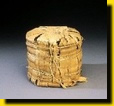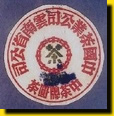Let¢s Drink for Our Pleasure - Pu¢er Tea and Teaware
Thematic Rooms, T.T. Tsui Gallery of Chinese Art,
Hong Kong Heritage Museum
11 January 2004 - 29 November 2004
One cup and two pieces is a common colloquial saying that refers to drinking tea while enjoying "dim sum". It is what Hong Kong people typically call "yum cha".
Hong Kong has long enjoyed the custom of going for "yum cha": as early as the middle of the 19th century, restaurants serving tea and dim sum stretched from the western district of Sai Ying Poon to Wellington Street in Central. Most of these traditional tea restaurants (Teahouses) have already closed their doors, but some can still be found that have remained in business for over half a century, and they continue to serve many different types of dim sum.
Tea is a wonderfully soothing drink to settle the stomach after you have eaten dim sum, and that is why most restaurants have a variety of teas for customers to choose from, such as pu'er, shoumei, jasmine, etc. Pu'er remains the most popular choice among Hong Kong's tea drinkers, however, as it is said not only to help quench the thirst and dissolve the fats in greasy foods, but also; what's more, it is not bitter, so it is easy on the stomach. Pu'er can be stored for an extensive period of time and it has a relatively long durability when it comes to its infusion qualities. Thus, restaurant owners and households alike can stock up on pu'er tea leaves, and this also contributes to its popularity. In recent years, pu'er has become something of a collectible: famous brand tea cakes such as "Song Pin", "Tong Qing", "Tong Xing" and "Tong Chaong" are the representatives, helping the tea live up to its name of a "drinkable antique".
So what is the history, what are the characteristics of this tea, pu'er, that is an everyday accompaniment in the lives of so many Hong Kong people? Taking you on a tour of some sophisticated collections of lidded cups, this exhibition provides the answers as it lets you experience the joys of pu'er.
Exhibit Highlights


|
Tong Xing Brand Tea Cake (Restored with original packing), Tong Xing Tea Cake
Early 20th century
Collection of Sun Sing Tea
Antique Pu'er tea is appreciated according to its vintage year; and it is considered the older naturally being the better (depending on the storing conditions). Connoisseur of antique Pu'er regard it as the ultimate for collecting.
|
|
 |
 |
Song Pin Brand Tea Label
Collection of Sun Sing Tea
The content, design and printing technique of tea labels have all evolved over time and reflected the development of printing technology, social, customs and sales method of tea trade for the past hundred years. Due to the rarity of antique Pu'er tea, their tea labels have thus become collectible. (Mr. Kings Yeung)
|
 |
|
 |
 |
 |
A/B-grade Blue Label Pu'er Tea Cake Wrapping Paper
1950s
Collection of Mr. Wong Hon Kin
In order to promote sales, the China Tea Company graded its tea cakes by putting green mark "甲" (A grade) and "乙" (B grade) classifications on the wrapping paper. This was not well received by the market, and sales did not improve. Blue ink was used to cover the "甲/乙" grading that on the wrapping paper. However, the blue ink faded to reveal the marks "甲" (A grade) and "乙" (B grade) in due course.
|
|
 |
 |
Moulds for Making Tea
1990s
Collection of Lam Kie Yuen Tea Co., Ltd
|
 |
|
 |
 |
 |
Rattan Sieves
Collection of Sun Sing Tea
Teashops use different size and density rattan sieves to separate tea leaves. This involves four steps: Lao, Shai, Ta and Bo:
Lao means shaking up and down. Its purpose is to separate coarse tea leaves from fine ones. Coarsely tea leaves remain on the top while the fine ones move to the bottom.
Shai means shaking left and right. Again, this process separates coarse tea leaves from fine ones.
Ta means shaking up and down vigorously in order to separate long and straight tea bones.
Bo aims to throw out tea dust.
|
|
 |
 |
Precious Objects and Floral Brocades
Covered Bowls and Saucers with Panels
Painted in Overglaze Enamels on Pink-ground
Late Qing to mid 20th century
Collection of Mr. Lewis S.N. Tung
|
 |
|
 |
 |
 |
Flowers, Birds and Butterflies Covered
Bowls and Saucers Painted in Overglaze Enamels
Late Qing to mid 20th century
Collection of Mr. Lewis S.N.Tung
|
|
 |
 |
Dragons and Phoenixes Covered Bowls
and Saucers with Panels Painted in Overglaze Enamels on Red Ground
Late Qing to mid 20th century
Collection of Mr. Lewis S.N. Tung
|
 |
|
 |
 |
Other Past Exhibitions
|








